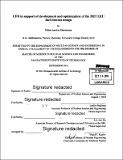CFD in support of development and optimization of the MIT LEU fuel element design
Author(s)
Diaconeasa, Mihai Aurelian
DownloadFull printable version (19.99Mb)
Alternative title
Computational fluid dynamics in support of development and optimization of the Massachusetts Institute of Technology Research Reactor low-enriched uranium fuel element design
Other Contributors
Massachusetts Institute of Technology. Department of Nuclear Science and Engineering.
Advisor
Emilio Baglietto and Lin-wen Hu.
Terms of use
Metadata
Show full item recordAbstract
The effect of lateral power distribution of the MITR LEU fuel design was analyzed using Computational Fluid Dynamics. Coupled conduction and convective heat transfer were modeled for uniform and non-uniform lateral power distributions. It was concluded that, due to conduction, the maximum heat flux ratio on the cladding surface is 1.16, compared to the maximum volumetric power generation ratio of 1.23. The maximum cladding temperature occurs roughly 0.5 inches from the edge of the support plate, while the peak volumetric power generation is located at the end of the fuel meat, about 0.1 inches from the edge of the support plate. Although the heat transfer coefficient is lower in the corner of the coolant channel, this has a negligible effect on the peak cladding temperature, i.e. the peak cladding temperature is related to heat flux only and a "channel average" heat transfer coefficient can be adopted. Moreover, coolant temperatures in the radial direction are reasonably uniform, which is indicative of good lateral mixing. Finally, a quasi-DNS study has been performed to analyze the effect of the fuel grooves on the local heat transfer coefficient. The quasi-DNS results bring useful insights, showing two main effects related to the existence of the grooves. First, the increased surface leads to an increase in the pressure drop and further, the flow aligned configuration of the grooves limits the ability of the near wall turbulent structures to create mixing, leading to a noticeable reduction in the local heat transfer coefficient at the base of the grooves. Overall, this leads to an effective decrease in the local heat transfer coefficient, but due to the increased heat transfer surface the global heat transfer is enhanced in comparison to the flat plate configuration. The improved understanding of the effects of grooves on the local heat transfer phenomena provides a useful contribution to future fuel design considerations. For example, the increase in pressure drop, together with the reduction in the local heat transfer coefficient indicated that the selection of a grooved wall channel instead of a smooth wall channel might not necessarily be optimal, particularly if fabrication issues are taken into account, together with the concern that grooved walls may promote oxide growth and crud formation during the life of the fuel.
Description
Thesis: S.M., Massachusetts Institute of Technology, Department of Nuclear Science and Engineering, 2014. Cataloged from PDF version of thesis. Includes bibliographical references (page 85).
Date issued
2014Department
Massachusetts Institute of Technology. Department of Nuclear Science and EngineeringPublisher
Massachusetts Institute of Technology
Keywords
Nuclear Science and Engineering.